A Tour That Will Live in Infamy
Saturday, January 28, 2012 – Boston, MA
SABR Day in America
Saturday was “SABR Day in America”, when local chapters of the Society for American Baseball Research planned baseball-related events across the country. Since it was a mild, sunny day and I had my online ticket sale needs wrapped up early, I decided to join the Boston group at their event – a walking tour that provided a light-hearted look at lesser-known and somewhat infamous sites around the Fenway area.
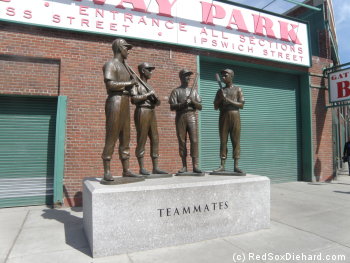
The Teammates statue sits outside of the entrance to the right field stands, on the corner of Ipswich and Van Ness streets.
Our first stop was the Teammates statue outside Gate B. There was nothing infamous about the four players depicted, but rather the spot was chosen because it’s the entrance to the right field stands. Our guide shared a story about 30 men who were ejected from the right field area at a game in July of 1912 for yelling insults at the Boston players. They made an example of those rowdy fans because the following week the Detroit Tigers were coming to town, and they wanted the great Ty Cobb to “get a fair shake”. We also learned that Van Ness Street was named by John I. Taylor, the Red Sox owner who built Fenway Park, after his wife’s maiden name.
From there, we progressed to the steps outside Gate A, where we heard more tales of people ejected from the World Series games in 1912. One group of men sued the Red Sox, since they had made the “great sacrifice” of $3 to purchase tickets to the game, and were further outraged when their bribe of $15 to let them stay was rebuffed. Another story was the scandalous tale of a woman from New York who had been loudly shouting and “raving” for the Giants and was found passed out in the stadium after the game. She was taken to the hospital where she continued to rave all night. The newspaper made sure to report that she was dressed all in silk, “including her undergarments”, and carried a velvet purse.
While outside the park, we also listened to a couple of songs about famous and infamous moments in Red Sox history – like an old-time rendition of the 1903 version of “Tessie” which had a modern twist; a song about the 2005 season called “No Pedro, No Nomar, No Lowe”
; and Gene Stamell’s “Billy We Hardly Knew Ye” off the Diamond Cuts: Bottom of the Fifth
CD, about Game 6 of the 1986 World Series.
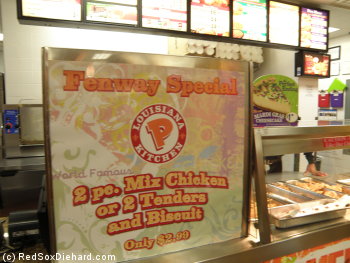
"Fenway Special" indeed. Is this what the guys were eating in the clubhouse last September?
Our next stop was the Popeye’s fast food fried chicken restaurant on Brookline Ave., to commemorate the epic collapse of 2011 which included certain members of the starting rotation eating fried chicken and drinking beer in the clubhouse during games.
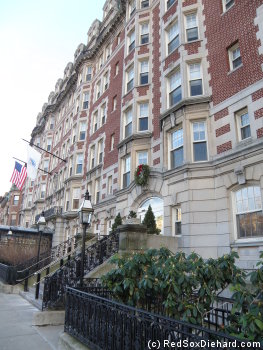
490 Commonwealth Avenue, site of the former Hotel Kenmore.
Next we walked through Kenmore Square, which was called Governor’s Square back in the early days of Fenway Park, to the site of the old Hotel Kenmore. Later a dorm for Grahm Junior College, and now apartments, in the early 20th Century the building was the largest hotel in the area. Its claim to fame is that it served as the visiting teams’ hotel, and is the only hotel to have hosted all major league teams (that existed at the time), including National Leaguers who came to town to play the Braves.
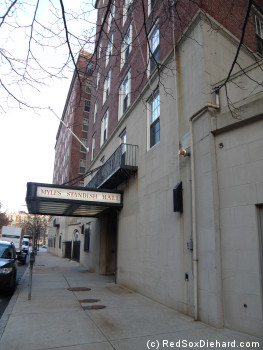
BU's Myles Standish Hall used to be a hotel frequented by Babe Ruth.
Our next stop was Myles Standish Hall at 610 Beacon Street. It’s now a Boston University dorm, but before 1949 it was the Myles Standish Hotel. It was a favorite of Babe Ruth, who always stayed in room 818 when in town to play the Red Sox. We also learned that Red Sox pitcher Ellis Kinder almost burned it down one night when he fell asleep with a lit cigarette.
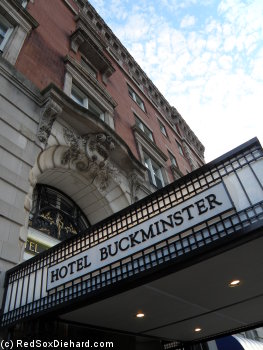
The Hotel Buckminster, where the Black Sox scandal of 1919 was planned.
From there we walked back up to the Hotel Buckminster at 645 Beacon Street, which is notorious for being the spot where gambler Joseph “Sport” Sullivan met with Chicago first baseman Chick Gandil to propose fixing the 1919 World Series. In the lobby of the hotel where the Black Sox scandal was hatched, we learned about that afternoon’s game against the Red Sox, a contest won by Chicago 3-2 on the strength of pitcher Eddie Cicotte, who was another one of the players in on the fix.
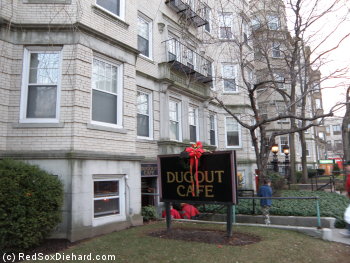
The Dugout Cafe, a frequent haunt of Pinky Higgins.
Our final stop was the Dugout Cafe, a few blocks up the street at 722 Commonwealth Ave. It’s now mostly a B.U. hangout, but it was one of the first bars to open in Boston after the repeal of Prohibition, and a couple of decades later was said to be a favorite post-game spot of Pinky Higgins. Higgins, who served as both manager and general manager of the Red Sox in the late 50’s, is known as one of the people responsible for making the Red Sox the last team to integrate, and it’s said that while at the Dugout he would sometimes drink so much that he’d fall off his barstool. I’m happy to report that no one in our group followed suit.



on February 1, 2012 at 9:35 pm
·